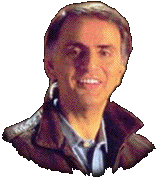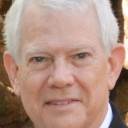November 9: Carl Sagan
Carl Sagan (1934)
It was on this date, November 9, 1934, that American astronomer and science author Carl Edward Sagan was born in New York City. Carl Sagan earned degrees in physics, astronomy and astrophysics. He taught at Cornell from 1968 and was a consultant on NASA's Mariner, Viking, Voyager and Galileo expeditions to other planets.
His books include the Pulitzer-winning Dragons of Eden (1977); the novel, Contact (1985), which was released as a film in 1997; and The Demon-Haunted World (1995) with his wife, Ann Druyan. Sagan was creator and host of the 1980 Emmy- and Peabody-award-winning public television series "Cosmos," which accompanied his best-selling book. The following year (1981) Sagan was named Humanist of the Year by the American Humanist Association, "in recognition of his work as an educator, skeptic, activist, and popularizer of science."
He rarely criticized religion bluntly, preferring instead to couch his views in terms of the superiority of the scientific method in gaining knowledge. In Sagan's words,
In science it often happens that scientists say, "You know that's a really good argument; my position is mistaken," and then they would actually change their minds and you never hear that old view from them again. They really do it. It doesn't happen as often as it should, because scientists are human and change is sometimes painful. But it happens every day. I cannot recall the last time something like that happened in politics or religion. ... The method of science is tried and true. It is not perfect, it's just the best we have. And to abandon it, with its skeptical protocols, is the pathway to a dark age.[1]
In 1996, Sagan was profiled by Jim Dawson in the Minneapolis Star-Tribune, and said, "My view is that if there is no evidence for it, then forget about it. ... An agnostic is somebody who doesn't believe in something until there is evidence for it, so I'm agnostic." He said much the same to Parade magazine, for which he was contributing editor. "There was no conversion in his deathbed," said Druyan. "Neither did he call to God, nor on hope in another life, nor pretend that he and I, who were inseparable for 20 years, were not saying good-bye forever." Furthermore, said Druyan, "Carl never wanted to believe. ... He wanted to know."[2]
Sagan gave his religious views most candidly in his 1996 book, The Demon-Haunted World:
Think of how many religions attempt to validate themselves with prophecy. Think of how many people rely on these prophecies, however vague, however unfulfilled, to support or prop up their beliefs. Yet has there ever been a religion with the prophetic accuracy of science? ... No other human institution comes close.[3]
In discussing The Demon Haunted World with Dawson, Sagan was asked about people who claim a "genuine mystical experience." Like a good scientist, Sagan turned the question around:
Your question presupposes the existence of a genuine mystical experience and I'm not sure what that is. People have vivid hallucinations. How do you distinguish between altered states of consciousness? ... If someone who has had an experience that tells us something about the universe that we didn't know and that later turns out to be true, then we'd have to say, "My goodness." ... But that would have to be more than the anecdotal reports that typically are used to support religious experiences.[4]
Carl Sagan suffered from a rare blood disorder that led to cancer and ultimately to his death on 20 December 1996. He remained skeptical until the end, saying, "If some good evidence for life after death were announced, I'd be eager to examine it; but it would have to be scientific data, not mere anecdote. ... Better the hard truth, I say, than the comforting fantasy."[5]
After his death, Carl Sagan's wife and co-author Ann Druyan wrote,
When my husband died, ... many people would ... ask me if Carl changed at the end and converted to a belief in an afterlife. ... Carl faced his death with unflagging courage and never sought refuge in illusions. ... I don't ever expect to be reunited with Carl. ... Every single moment that we were alive and we were together was miraculous – not miraculous in the sense of inexplicable or supernatural. ... We found each other in the cosmos, and that was wonderful.[6]
[1] Internet Movie Database (http://us.imdb.com/name/nm0755981/bio).
[2] "In the Valley of the Shadow," Parade magazine, March 10, 1996.
[3] Carl Sagan and Ann Druyan, The Demon-Haunted World, 1996, p. 30.
[4] Jim Dawson, profile of Carl Sagan, Minneapolis Star-Tribune, March 1996.
[5] Demon-Haunted World, p. 204.
[6] Ann Druyan, "Ann Druyan Talks About Science, Religion, Wonder, Awe ... and Carl Sagan," Skeptical Inquirer, November/December 2003, p. 30.
Originally published November 2003 by Ronald Bruce Meyer.


